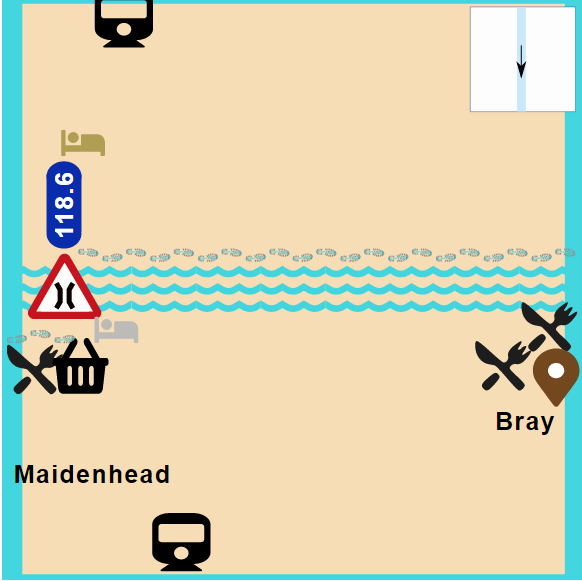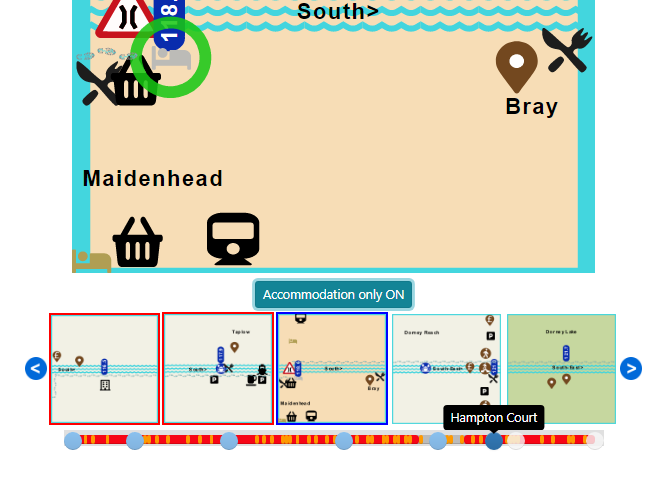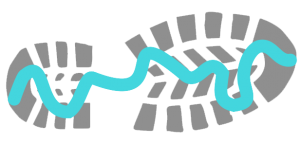How to Use the Map Route Planner
How to Use the Map
Most importantly, this is not a map in the traditional sense. Do not use it to follow the Path. You must use an Ordnance Survey map for that. This is a topological representation of what you will find on the route. It has been prepared to assist you in planning your itinerary: so that you know how far you will be walking, where you can get refreshments (be it shops, cafes), where you can stay at night, transport to and from the route and places of interest that you may want to detour to.
Why Topological?
A topological map is a type of diagram that has been simplified so that only vital information remains and unnecessary detail has been removed. These maps may lack scale, distance and direction but the relationship between points is maintained.
The Thames flows broadly in a direction from West to East, or left to right. It was therefore logical to arrange pages in a swipe left and right mode, even when the river turns north or south. We have stretched out the Thames in a straight line running left to right. By making the map topological, we are able to remove items that are irrelevant for Thames Path walkers (such as railway bridges that a pedestrian cannot use).
Scale and Positioning
Each page on the map is 1.25 miles by 1.25 miles (2km by 2km) with the river running through the centre. It means that the distance from the river to the top and bottom of the map is always 0.6 miles (1km). We chose this as we thought that is probably the maximum distance anyone would want to deviate from the route.
All objects shown on the map are approximately correct in respect to distance from the river. However, where objects clash we have shown the objects as they relate to each other. Thus, a street with a shop, a restaurant, a pub and a hotel would show as a strip and some points would not be completely accurate.
We have also shown some items that are important enough to be included but are not within 0.6 miles of the river. These are shown on the top and bottom edges of the map. Wherever they have been “squeezed in”, we have shown how far they are from the river. If no mention of distance is made, then the distance is accurate.
Obviously the Thames does not flow in a straight west-east line. So we have included a diagram of the approximate direction of the Thames in the top right hand corner.


Navigating between the pages
You can scroll to the left and right by clicking on the blue edge of the map. You can also go to another page by clicking on any of the 5 tiles below. The middle tile should be the map you are currently on. The tiles to the left are upstream; the tiles to the right are downstream. Tiles with a red outline indicate that there is no accommodation available or the tile is out of range from the walking distance you have set.
Below the main map is a button which allows you to filter on only those pages with accommodation. When the filter is set, the tiles below are also filtered.
You will also see a slider at the foot of the page. This allows you to navigate quickly between any of the pages on the map. The slider does not show when the accommodation filter is set.
Distances
Distances are shown cumulatively in miles from the source. This is calculated based on the Thames Path and not the river. To convert to Km multiply by 1.6. They are shown at key “break points” (villages, bridges, locks etc). On the page title at the top, you will also see the cumulative distance of that page. Both the distance from source and distance from mouth are shown. Distance from source is on the left; distance from mouth is on the right.
When you select accommodation it will tell you the exact distance from your last stop.
Paths and Bridges
The approximate route of the Thames Path is shown in relation to the river (which is shown as a straight line). Where, in London, the Path can be walked on either side, two paths are shown. Footpaths leading off the Path are also shown.
All river crossings available to walkers are shown. These can either be over a footbridge, a road bridge or a tunnel. Bridges that cannot carry pedestrians (some railway bridges and motorway bridges for example) are not shown as they are not relevant.
Accommodation
We have only included accommodation that is available through our packages.
Refreshments (cafes, restaurants, pubs and shops)
The Thames Path can go from “feast to famine” and back in a short distance. Sometimes there are no facilities. Then suddenly there are lots.
Where facilities are limited i.e. in rural areas, we have shown all potential refreshment stops. Where facilities are plentiful (such as in towns), we have shown a selection of what is available. This reflects the purpose of the map: which is to help plan your itinerary. Therefore, you need to know where you can stop for food.
In central London, we have decided not to show any places of refreshment as there are so many available
Transport (Rail, Bus, Boat, Parking)
The most reliable, simple and integrated form of transport is rail. We have therefore shown all stations on or near the Path with a brief explanation of times and directions of trains together with a link to some diagrams we have put together on rail and bus routes on the Thames. Although we have shown bus routes, these are only in place where a rail service is absent.
There are a number of boat services up and down the river, some for leisure and some for commuters. These are also included.
We have not shown any car parks downstream of Hampton Court as the Path is well served by public transport.
Points of Interest
We have categorised points of interest into paid and unpaid. Some of the free attractions do require payment for viewing special exhibitions. Some of the paid attractions can be admired from outside without having to pay anything.
Feedback
Your feedback is most valuable, whether they be errors that you have picked up, (there will be some!) or suggestions for improvement. Use the form below to help us improve.

